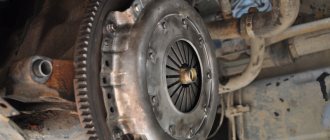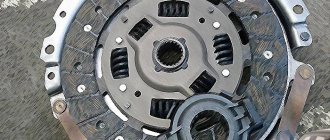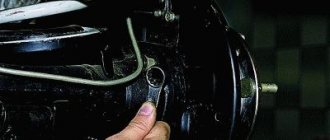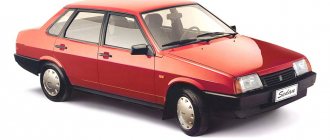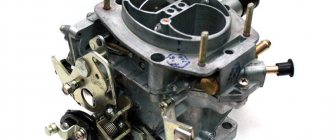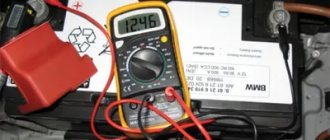Hi all! Clutch failure does not bode well for the car and its owner. The sooner signs of problems can be detected, the better. A fairly common question on this topic is why the clutch slips or slips. Different terminology is used, but the essence remains the same.
It is important to understand that modern cars use dry and wet, also known as oil, clutches. In the first case, we are talking about simple friction, while in the second, the procedure is carried out in a special oil, which additionally cools the clutch discs and other elements. Most often we encounter the dry type. Wet is used on cars with dual clutch and robotic gearboxes. It is difficult to adjust and repair a wet clutch with your own hands. This requires the help of specialists.
The most common sign of unit malfunction is slipping. Moreover, for some it happens constantly, while for others it sometimes stalls, sometimes not. This can happen both hot and cold, that is, before and after the unit warms up.
How the problem manifests itself
Most often, the cause of clutch slipping is normal mechanical wear of the assembly elements. This allows you to diagnose an impending problem even before serious consequences appear. This is done by simply observing changes in the behavior of the machine.
If you notice one of the following signs on your Niva, passenger car or scooter, be sure to diagnose the clutch or contact a service center.
- Extraneous sounds occur during system operation. They appear in the form of knocking noises when the pedal is depressed or released;
- If the noise disappears when the clutch pedal is depressed, the problem is most likely in the release bearing;
- There are signs of vibration on the pedal;
- In this case, the pedal may sink too much or be pressed too hard;
- A characteristic burning smell emanates from the clutch. The clutch usually burns if the driver operates it incorrectly.
The manufacturer provides each vehicle with instructions that indicate all recommendations for routine maintenance and replacement of clutch assembly elements. Most often, the driven disk needs to be replaced.
Before you try to adjust the system yourself, be sure to familiarize yourself with the principle of operation of the clutch. In our previous article we discussed this issue.
Why does the clutch slip? Causes and solutions
Clutch slipping can cause problems associated with deterioration of vehicle traction and dynamics during acceleration. There may be several reasons why the clutch slips:
- Worn friction linings.
- Little free play in the clutch pedal.
- Oil that has got on the friction linings.
- Loss of elasticity of pressure springs (metal fatigue), etc.
If while driving you notice an unpleasant odor similar to the smell of burnt rubber, and your car begins to slowly pick up speed and does not pull at all on inclines, most likely your car’s clutch does not engage completely or, more simply put, “dies.”
How to check whether the clutch is slipping or not?
To confirm or deny slippage, do the following:
- With the engine running, pull the brake lever all the way.
- Shift into gear, then gently press the gas pedal and slowly release the clutch.
The engine should stall, this will mean that everything is in order, but if not and the engine is still running, your clutch is slipping. In this case, check how easily the clutch pedal moves; if its movement is limited, then try adjusting it and check if the problem has disappeared.
- If the clutch slips due to worn clutches, you need to find out how much wear there is.
- If you are lucky and it is small, slipping can be eliminated by adjusting the pedal free play.
- If the wear of the friction linings is too great (when the distance between the rivets and the working elements is more than 0.2 mm), the driven disk must be replaced along with the linings.
It also happens that the linings become oily due to excess oil in the gearbox or clogged flywheel drain holes. In this case, the solution to this problem comes down to the usual washing of the linings with kerosene; upon completion, everything is thoroughly wiped and sanded with sandpaper. Sometimes the clutch slips due to swollen rubber parts of the clutch hydraulic drive, to check this you need to do the following:
- Remove the master and slave cylinders.
- Disassemble and flush the system with alcohol.
- Replace swollen parts with new ones.
- Cleaning the expansion holes won't hurt either.
At the end of the work, fill in the brake fluid and bleed the brakes. If your car is more than 10 years old, it is possible that the reason for the clutch slipping lies in the pressure springs that have lost their elasticity. As a result of this phenomenon, the pressure on the driven disk is insufficient, which will one way or another lead to problems with slipping. The condition of the springs can only be judged after removing the entire clutch disc; if necessary, the springs can be replaced or the clutch can be completely replaced.
Possible consequences
A slipping clutch is a fairly common occurrence. This is especially true for domestic cars, motorcycles and cars with high mileage.
Practice and experience clearly show that slipping is usually associated with wear and damage to elements. This can happen on any car or other vehicle. Judging by the requests of fans of self-repair, most often the problem of a slipping clutch is solved on the following vehicles:
- VAZ 2107;
- VAZ 2114;
- IZ Planet;
- UAZ Bukhanka;
- Jupiter;
- KAMAZ;
- Minsk;
- VAZ 2110;
- Renault Logan;
- Kia Rio;
- Lada Priora;
- GAZelle, etc.
Despite the obvious cause of such problems, many car owners stubbornly continue to ignore all recommendations for maintenance and timely repair of the unit.
If you feel characteristic signs of problems, you should take prompt action.
When buying a used car or getting behind the wheel for the first time, some people think that they are simply driving the vehicle incorrectly, are not yet fluent in manual shifting techniques and are making some mistakes. In reality, it may turn out that the clutch is failing.
It is important to pay attention to the characteristic signs. Namely:
Is it possible to drive like this?
It is highly undesirable to continue operation with a slipping clutch. It is not always possible to accurately control the moment when sliding begins, and this will release significant power.
So much so that the linings can burn completely in a matter of seconds. After which the car will be completely immobilized, possibly in a dangerous place on the road, and during repairs it will also be necessary to replace the flywheel, which is covered with cracks from overheating.
After the first signs of slipping, you must, without sudden acceleration and at low speed, proceed to the repair site, where you can replace the complete clutch. Attempts to save money on individual parts usually lead to unnecessary work on removing and installing the gearbox.
Safety chain (cable) for a trailer: why is it needed, how to attach it
- the car loses dynamics;
- cravings drop;
- the car is difficult to climb;
- speed is gained slowly;
- the pedal vibrates;
- there is a smell of burning in the cabin;
- the pedal is too tight;
- the pedal fails;
- gear shifts with a crunch;
- Extraneous uncharacteristic sounds appear when switching.
If you do not pay attention to this in time, the engine flywheel is highly likely to be damaged, not only the coupling unit, but also the gearbox will suffer. The problem mainly affects the gearbox input shaft.
Why does the clutch slip in a car and how to fix it
Traditionally, the main components of a car are its engine and gearbox. The first converts thermal energy into kinetic energy, the second transmits torque to the wheels. But without a clutch, both units are useless - it is this that provides the connection between the engine and transmission.
Like the power unit, the clutch is subject to high loads, which do not always go unnoticed. The main clutch malfunction is considered to be slipping.
This term refers to the impossibility of ensuring the transmission of torque to the transmission without loss. This, in turn, is fraught with a loss of vehicle dynamics, the appearance of vibration and extraneous sounds when changing gears.
Why does the clutch slip?
First, let's briefly describe the principle of operation of the clutch. When you press the pedal, the moment of movement is transmitted to the fork and through it to the release bearing itself. He, in turn, presses on the spring petals, pushing the pressure and driven disks apart. The latter disengages from the flywheel, and the input shaft of the box is left without torque.
When they say that the car’s clutch is driving, this means that it is not fully engaged. That is, pressing the pedal does not completely disconnect the gearbox shaft from the motor flywheel.
Let's consider the main reasons for this condition:
- drive is not adjusted. This means that even fully pressing the pedal all the way is not enough to completely disconnect the crankshaft from the friction lining. Typically, such a nuisance appears after repair work has been completed;
- deformation of the driven disk. A change in its geometry causes the friction lining, after disconnecting the pressure disk in the deformed area, to continue to come into contact with the flywheel. If strong axial runout occurs, the deformed disk must be replaced. A sign of such a malfunction is the appearance of vibration when starting the car;
- weakening of the diaphragm spring blades. The consequences are the same as if the pedal travel is insufficient - the pressure plate is not completely disconnected from the driven one. Petals may break, with the same consequences. This usually happens due to a manufacturing defect, as well as due to incorrect drive adjustment. The main reason for the weakening of the petals is natural: metal fatigue;
- The clutch may slip due to a hydraulic malfunction. This may be a depressurization of the system, when a brake fluid leak causes a drop in pressure in the system and the inability to disengage the clutch completely. It is also possible that the working cylinder may break, due to which the crankshaft remains partially engaged with the input shaft of the box;
- loss of mobility of the cable drive. The metal cable frays over time, increasing in cross-section in certain areas. This leads to it jamming, although it seems to the driver that the pedal is fully depressed. In this case, the clutch will also slip;
- the driven disk may also lose mobility. This happens due to the lubricant drying out, when dust and dirt get on the working surface, and also due to uneven wear of the splines. In such cases, when the pedal is pressed, the clearance required to separate them is not achieved between the pressure plate and the flywheel;
- Another reason that the clutch is slipping may be flywheel deformation. When it becomes bent in the radial plane or significant scuffing occurs, the flywheel will not be completely disconnected from the clutch. Since the flywheel is a massive part, vibration is usually observed when it is bent, especially at the moment of starting;
- It is also possible that the fork responsible for moving the release bearing may bend. In this case, the stroke of the rod is correspondingly reduced with corresponding consequences.
Schematic illustration of a clutch system in a car
Signs of a bad clutch
Problems in the functioning of the clutch always affect the behavior of the car. But drivers, especially inexperienced ones, do not always associate the changes in the movement of the car with the operation of the clutch. Let's look at how to independently check whether the clutch is slipping.
The most common symptom indicating a problem with this unit is incomplete shutdown. This malfunction can manifest itself in different ways. In some cases, the car may move jerkily, vibration may occur when you press the pedal, and extraneous noise may appear when changing gears.
Independent and quick diagnostics
If this is just the beginning of the emergence and development of a problem associated with clutch slipping, inexperienced drivers may not notice it.
There is a fairly simple diagnostic method that is almost error-free. You can do it yourself after replacing the clutch, when adjustments have been made, or simply when you suspect that the system is not working correctly.
VAZ clutch slips - possible causes and solutions
Clutch slipping in a car, first of all, affects the deterioration of traction and also negatively affects the dynamics. There are several reasons why the clutch may start to slip; in this article you will learn in detail about each of them, as well as how to eliminate such a nuisance as clutch slipping.
Clutch slips - reasons:
- Clutch pedal travel is too small;
- Friction linings that are too worn;
- Poor elasticity of pressure springs;
- Oil getting on the friction linings.
Signs of a slipping clutch:
- A specific smell similar to the smell of burnt rubber;
- The car does not pick up speed well;
- On inclines the engine does not pull.
HOW TO CHECK WHETHER THE CLUTCH SLIDS OR NOT?
- Start the engine and tighten the handbrake.
- Shift into gear and begin to apply the gas smoothly while releasing the clutch. If after this the engine of your car stalls, we can conclude that your clutch is ok. If the engine does not stall, but the car starts moving, we conclude that your clutch is slipping.
What to do in such a situation? I recommend checking the ease of movement of the clutch pedal; if you find any problems, try adjusting the clutch. It is possible that the clutch slips due to serious wear of the clutches, in which case you should find out how much wear there is. If the wear is small, clutch slipping can be eliminated by adjusting the pedal free play, otherwise the driven disk will need to be replaced along with the linings. As a rule, this is done when the distance between the working elements and rivets exceeds 0.2 mm. Sometimes the linings can become oily due to the oil level in the box being too high, as well as due to clogged flywheel drain holes. The solution to this situation will be quite simple; all that is necessary is to wash the linings with kerosene. After such a wash, all surfaces are thoroughly wiped and sanded.
There are cases when the clutch slips due to swollen rubber parts of the clutch hydraulic drive. To confirm or refute this assumption, you must do the following:
- Remove the working cylinders along with the main one;
- Using alcohol, flush the entire system;
- Replace parts that are swollen with new ones;
- Clean the expansion holes;
- Upon completion of the procedure, fill in the brake fluid and bleed the brakes.
In cars that are 10 years old or more, clutch slipping is possible due to loss of elasticity of the pressure springs; as a result, the pressure on the driven disc becomes insufficiently large, resulting in problems with slipping. To assess the condition of the springs, you will need to remove the entire clutch disc; if necessary, the springs are changed or the clutch is completely replaced.
That's all I wanted to say. I look forward to your comments. Thank you for reading VAZ DIY Repair, see you next time!
Other articles about clutch:
Do you need a trailer inspection?
- place the machine on a level surface;
- start the engine;
- turn on the handbrake;
- go into first gear;
- start trying to move away;
- gradually press on the gas;
- release the clutch at the same time;
- watch the result.
If the engine stalls during such manipulations, this is good. That is, the clutch does not slip. But when the engine does not stall, the car begins to move, the unit actually slips.
Appropriate measures should be taken immediately to correct the problem.
Why might the clutch slip in a car?
The clutch in a car is needed so that the car owner can move away or change gear. Like any car part, the clutch can wear out over time. This can most often be understood by slipping. This phenomenon negatively affects the dynamics of the car and sometimes leads to problems with the automatic transmission. To prevent such unpleasant consequences, you need to know why the clutch slips and how to deal with this problem.
How to check whether the clutch is slipping or not?
To understand whether there is slippage, you need to perform the following steps:
- Pull the brake lever all the way with the engine running;
- go to first gear;
- Release the clutch very slowly, while gently pressing on the gas.
If the engine stalls after such actions, this means that the clutch is in order. If the engine continues to operate, it means the clutch is slipping. In this case, adjusting the clutch pedal can help. If after adjusting the pedal the problem does not go away, it may be due to worn friction linings. If there is slight wear, the problem can be eliminated by adjusting the pedal free play. If there is a lot of wear, the distance between the friction linings becomes more than 0.2 mm, and in this case you will have to install a new disc and new linings.
Sometimes the pads can become oily. The reasons for this are excess oil in the automatic transmission or clogged drain holes in the engine flywheel. In this case, you should simply wash the pads with kerosene, wipe dry and sand with sandpaper. Another reason for clutch slipping is the hydraulic clutch parts, which can swell over time. To check if this is the problem, you need to remove both cylinders, disassemble and wash everything with alcohol, replace the swollen rubber parts with new ones. You can clean the expansion holes.
After this, brake fluid is added. The clutch can also slip due to pressure springs. This applies to old cars with a service life of more than 10 years - in such cars the springs may lose their elasticity. The pressure of the driven disc decreases, and problems with slipping begin. To understand the condition of the springs, you will have to remove the entire clutch disc.
If it doesn't turn on completely
A malfunction of the clutch system is indicated by factors such as a burning smell when driving, significant deceleration of the car on inclines, sluggish acceleration on a flat road. To find out whether the clutch is slipping or not disengaging completely, you need to pull the brake lever with the engine running, then engage first gear and, while gently pressing the gas, slowly release the clutch pedal.
A stalled engine will clearly indicate that there is no problem with clutch slipping. But if the engine continues to operate after performing these steps, this means that the clutch system is slipping.

